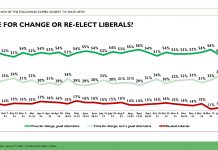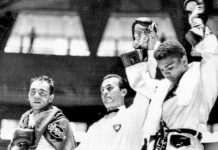In addition to telling a personal and political story about an important man, Lawton’s book also provides an invaluable aid to anyone seeking to understand the modern Conservative Party of Canada. Understanding the core of conservatism and respecting the constituent parts of the coalition is vital if a conservative leader is to be successful.
Andrew Lawton. Pierre Poilievre – A Political Life. Sutherland House, Toronto, 2024.
212 pp.
Review by Matthew Rowley
It turns out that there is a lot going on in the pages between the covers of Andrew Lawton’s new biography of Pierre Poilievre.
Lawton writes that his purpose is to explain “who Poilievre is, where he came from, and how he fits into the changing landscape of Canadian conservative politics,” all while recognizing that his story is ongoing, with chapters yet to be written.” In addition to being a political biography of an important man, Lawton’s book provides an invaluable aid to anyone seeking to understand the modern Conservative Party of Canada.
To accomplish this the veteran journalist, talk radio host and managing editor of the True North online news platform tells us a story in three parts, beginning in the Conservative leader’s early years in Calgary, then moving with Poilievre to Ottawa, mapping his rise through the ranks of Tory backbenchers into the cabinet of Stephen Harper, and finally following Poilievre’s contest for the party leadership to his decisive victory, tracking the direction that Conservative and Canadian politics has followed ever since.
In addition to telling a personal and political story about an important man, Lawton’s book also provides an invaluable aid to anyone seeking to understand the modern Conservative Party of Canada. Understanding the core of conservatism and respecting the constituent parts of the coalition is vital if a conservative leader is to be successful.
Lawton shows his ability as a journalist and storyteller in this work, weaving a compelling narrative of the rise of a young, slightly nerdy teen into the position of Leader of the Conservative Party of Canada. Throughout, it is an entertaining and engaging book, straying neither into too much detail, nor overly simplistic presentations of the past. The book is carefully researched, requiring dozens of interviews and archival study to produce. Lawton interviewed Poilievre’s family and friends, political colleagues and enemies, people from his past and the present. He ably shows the growth and development of a personality and a political sense that has made Poilievre into perhaps the most formidable Canadian politician of our time.
In the first of the three parts, Lawton tells the reader of Poilievre’s early years, recounting the (by now) famous story of Jason Kenney’s first interaction with him. The future MP, Harper cabinet minister and Alberta Premier overheard a teenager who sounded like a mature lawyer as he sold party memberships, closing far more sales than anyone had else ever seen. Poilievre is revealed as someone who had politics in his bones from the very beginning, attending pro-life rallies with his mom while in his early teens, working in campaign offices, and joining various campus conservative clubs in university.
Poilievre’s entry into the Magna International essay contest, “Building Canada Through Freedom,” becomes a key focal point throughout the book, with Lawton employing it to show not just major consistencies, but also shifts in thought or belief that are evident from the early days to the present.
Starting with his significant victory in 2004 against a sitting Liberal cabinet minister, the story of Poilievre’s election to the Commons shows both the tenacity and a willingness to think outside the box about issues and campaigns that have defined him as a leader.
Poilievre wrote in his essay: “Although we Canadians seldom recognise it, the most important guardian of our living standards is freedom: the freedom to earn a living and share the fruits of our labour with loved ones, the freedom to build personal prosperity through risk taking and a strong work ethic, the freedom of thought and speech, the freedom to make personal choices, and the collective freedom of citizens to govern their own affairs democratically.” These thoughts still appear to guide Poilievre the leader, just as much as they played a key place in the consciousness of the student.
Starting with his significant victory in 2004 against a sitting Liberal cabinet minister, the story of Poilievre’s election to the Commons shows both the tenacity and a willingness to think outside the box about issues and campaigns that have defined him as a leader. Lawton observes that he “didn’t change his values at the door, but he altered his messaging based on whomever was in front of him.”
Part two of the book details Poilievre’s arrival in the House of Commons and his time both in government and opposition. The detail of his membership in the “Khmer Bleu” group of Conservative caucus colleagues shows his early strength. Reflecting on his stance back in those early days also reveals some of the differences to be found in Poilievre today and his somewhat more ambiguous stance on social conservative issues.
His serious communication disaster in 2008 involving indigenous reconciliation marks a key moment. We see that Poilievre’s life has not been perfectly charmed. He is in fact capable of serious error. It also shows, however, that when he needs to, he is capable of showing “contrition and introspection,” as Lawton puts it. Notably, Poilievre resisted the powerful urge to discover a learning opportunity for all Canadians from his own actions, in contrast to Justin Trudeau.
Lawton describes Poilievre’s careful career as he participates in almost a decade of Conservative government, but also details his ability to maintain an important and growing position within the party through the surprising election loss of 2015 and the subsequent period in opposition.
Part three of the book explores Poilievre’s rise to the leadership of the Conservative Party and the subsequent direction conservative and Canadian politics has gone under his leadership. Lawton details the confident stance that Poilievre chose for the leadership race and emphasizes strongly his decision to take a novel approach compared to many other Conservative leaders. He writes: “the conventional wisdom of conservative politics is that you campaign to the right during a leadership race, and pivot to the centre when in the general election campaign.” Lawton shows that, so far, Poilievre has eschewed this approach, choosing instead to maintain the same tone and talking points that won him the leadership.
The task of getting to know a politician can be extremely challenging, even for Ottawa insiders. The closer that a political figure gets to the centre of power, the more their whole image is stage managed and protected by layers of carefully crafted messaging and a praetorian guard of people who ensure that the real person does not get into the firing line. To assault such a fortress is a difficult task, but Lawton manages to at least get onto the battlements, if not into the innermost room of the keep. The book is not a simple biographical account.
Noticeably absent, however, among all the interviews, is any direct interview for this book with Poilievre himself. Lawton has the best of secondary sources. But we are still left, at times, trying to guess or deduce what Poilievre was thinking or feeling at the various key stages in his life.
One is left to wonder why Poilievre and some of his closest circle were unwilling or unable to engage with Lawton as he wrote the book. Surely it was not because he did not ask them. It is this key drawback that leaves Lawton standing sometimes, outside those inner corners of the fortress, wondering what is going on in the inside, having to make well educated guesses as to the thought and motivation of the man and leader.
Lawton writes: “Poilievre serves up some apparent contradictions. He’s both everyman and the poster boy for career politicians. He is both loved and hated (with arguably similar levels of intensity). He is authentic and full of conviction, and yet every decision he makes—even the most mundane—is the product of calculation.”
Alongside the tales of his political acumen are stories of failure, as well as strong critiques of Poilievre’s past and current political decisions. This probing discussion of Poilievre is truly what sets this book apart as a must read for anyone who seeks to understand the Leader of the Opposition on a deeper level.
In the final section, Lawton takes time to evaluate not only Poilievre’s leadership, but also the policy directions and forces that are pulling the party in various directions. Lawton evaluates these forces and provides a valuable critique of Poilievre’s performance to this date, both good and bad. Especially important is his discussion of Poilievre’s credentials as a social conservative, as Lawton lays out the possible pitfalls of the approach Poilievre has chosen to take.
Lawton’s book reveals an utterly unique individual, whose rise to power combines dedication, hard work, and a touch of being in the right place at the right time.
Poilievre truly is a political animal, involved in the world of politics from his early teens. Lawton argues that Poilievre’s success to this point is due to a life devoted to climbing the political ladder. The book provides ample evidence to support his premise, guiding the reader through the whole history that started with a teenager manning the phone banks for an MP’s campaign, and has led so far to the leadership of the largest political party in Canada, and preparing to take up the office of Prime Minister.
Lawton also portrays a careful and thoughtful man, unwilling to live from the gut or shoot from the hip, but also able and willing to take hard decisions and go the unpopular way if he believes it to be right.
This dedicated life has led Poilievre to become an expert politician, but also given him time to learn the ropes and develop some humility, through the various bumps and bruises that he endured along the way. His life is a wonderful argument for the usefulness of a dedicated political class, growing and learning within the political world, but doing it in ways that keep him connected and rooted with the everyday people that truly make up the soul of the country.
Lawton also portrays a careful and thoughtful man, unwilling to live from the gut or shoot from the hip, but also able and willing to take hard decisions and go the unpopular way if he believes it to be right. This kind of a leader is surprisingly rare in political life, and it has not been a style without cost for Poilievre. Lawton’s portrait reveals someone who has had to fight the battles that happen when one stands on principle. Poilievre provides an example for young politicians that it is possible to rise in the political world without abandoning one’s principles.
Additionally, Lawton demonstrates that Poilievre has stayed consistent in his tone and approach to politics. Many people in the political world work to change their image or adjust their tone to better suit the accepted norm of the political and media classes. Poilievre has been a master at subverting those norms, refusing to live on the defensive or try to pander. Instead, his life story shows that he is willing to get out in front, speaking and acting boldly in the direction that he believes is right. He is also very effective at listening to average Canadians, rather than the political pundits, providing a true responsiveness that is paying dividends in his current approach to Conservative leadership.
For Canadian conservatives, both within the party and within the movement, Poilievre’s story provides a key lesson. The Canadian conservative movement is a movement of principled people.
Personal anecdotes and glimpses into Poilievre’s private life provide us with a more three-dimensional texture to the man. Learning that Poilievre does not like television, that he is a poor housekeeper, and that he had to work hard for his first kiss with his wife helps the reader to see that this man is not merely a robot spewing party political talking points, as some try to caricature him. Learning about his upbringing in a working-class family and neighborhood helps the reader to understand his strong desire to help people who are struggling to survive in similar circumstances. Realizing that he is a chess player grants an insight into his ability to effectively navigate the difficulties of modern political leadership.
Lawton also paints a helpful picture of a Conservative Party that succeeds when it is confident and sure of its direction but fails when it loses its focus or gets distracted by attempts to win favour with the media or the left. For Canadian conservatives, both within the party and within the movement, Poilievre’s story provides a key lesson. The Canadian conservative movement is a movement of principled people.
Those who grew up in the movement during the 1980’s and into the 1990’s know that if the party does not respect its base, they will not remain in the camp simply to win. The Reform movement and the more recent episodes involving Maxime Bernier, the PPC and the Erin O’Toole 2021 general election campaign show that there is often not actually much room for the “pivot” that Lawton so ably discusses.
Authenticity and principle are vital for the Conservative party to move forward as a team. When the leadership of the Conservative party comes across as inauthentic and unresponsive to its conservative base, there will always be a line over which the base will not cross.
As we have seen time and again, conservatives will sometimes surprise the experts and find a way to bring the party back onto a more conservative course. This has proven to be true, even if it means we find ourselves in the political wilderness for a season.
Poilievre so far has proven himself better than others when it comes to understanding the core of conservatism and respecting the constituent parts of the conservative coalition. You cannot have conservatism without conservatives. Ours is not merely a party, but an ideal that strengthens Canada and makes everyone’s life better. His rise to the party’s leadership reflects boldness, a principled outlook, a love of freedom, and an innate ability to harness and channel the conservative worldview into dynamic political action.
For anyone seeking a deeper understanding of Poilievre’s life and insight to predict how a Poilievre government will operate, Lawton’s book is invaluable. For those seeking a window on the history and the outlook for the modern Canadian conservative movement – through the lens of one life – Pierre Poilievre: A Political Life is well worth the read.

Matthew Rowley is president of Training Leaders International Canada, an overseas teaching organization. He holds a Bachelor of Theology from Clearwater College, an MDiv from Canadian Southern Baptist Seminary, and a PhD from McMaster Divinity College. His scholarship is heavily focused on the early development of the Canadian political, church, and educational systems, and he works to educate people on the history and philosophy of conservatism. He currently resides in Water Valley, Alberta.
























